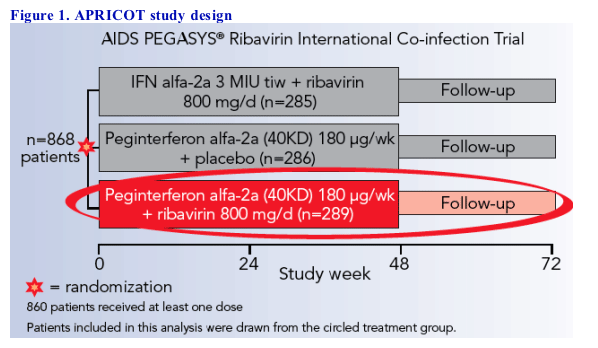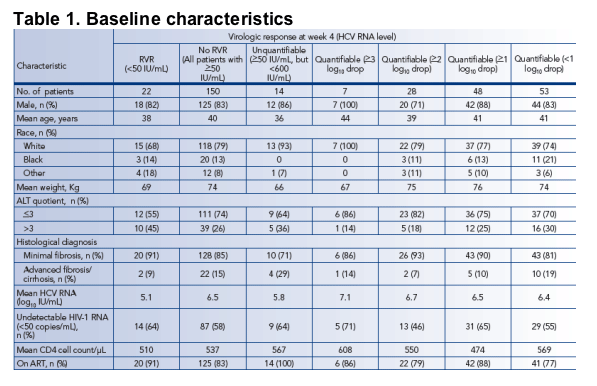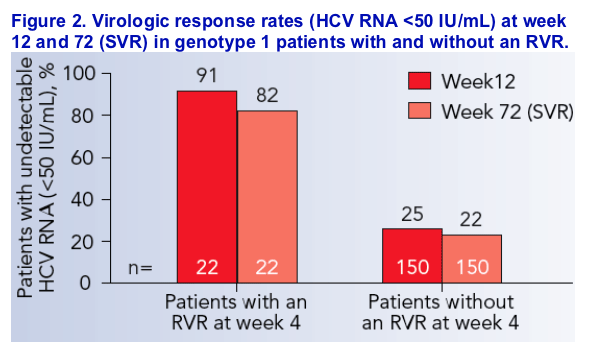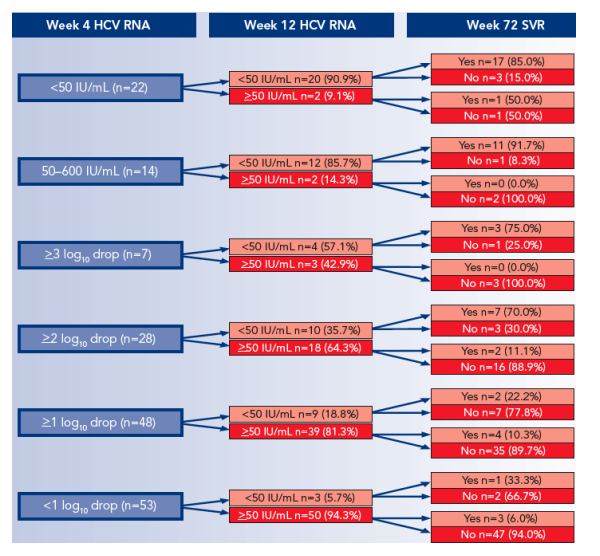 |
 |
 |
| |
Prediction of SVR in HCV genotype 1 patients co-infected with HIV based on virologic responses at week 4 and 12 of treatment with peginterferon alfa-2a (40KD) (PEGASYS) plus ribavirin (COPEGUS): Retrospective analysis of APRICOT
|
| |
| |
Reported by Jules Levin
AASLD Nov 4 2008 San Francisco, CA
M. Rodriguez-Torres,1 J. Rockstroh,2 J. Depamphilis,3 G. Carosi,4 D.T. Dieterich,5 F. Torriani6
1Fundacion de Investigacion de Diego, Santurce, PR, USA; 2University of Bonn, Bonn, Germany; 3Roche, Nutley, NJ, USA; 4Universita Degli di Brescia, Brescia, Italy; 5Mount Sinai School of Medicine, New York, NY, USA; 6University of California, San Diego, CA, USA
Introduction
The combination of pegylated interferon plus ribavirin is the treatment of choice for patients with hepatitis C virus (HCV) infection, including patients with HIV-HCV co-infection.[1, 2]
The success of HCV treatment in the setting of HIV-HCV co-infection is characterized by additive toxicities, comorbidities and a diminished response to combination therapy with pegylated interferon plus ribavirin in comparison to mono-infection.[3] The exact reason for the diminished response to combination therapy is unknown, but is attributable, in part, to higher baseline HCV RNA levels in the setting of HIV-HCV co-infection.[4]
Rapid virologic response (RVR), defined as undetectable HCV RNA (<50 IU/mL) after 4 weeks of combination therapy is an important predictor of sustained virologic response (SVR) in patients with HCV mono-infection.
Approximately 90% of mono-infected patients with an RVR achieve an SVR after 48 weeks of treatment.[5] Consistent with HCV mono-infection, RVR can be used to identify co-infected patients most likely to achieve an SVR.[6]
Patients without an RVR have a much lower likelihood of treatment success, but it is not clear whether all patients without an RVR are unlikely to achieve an SVR or if the probability is proportional to the magnitude of the drop in HCV RNA levels.
AUTHOR CONCLUSIONS
Among HIV-HCV co-infected genotype 1 patients treated for 48 weeks with peginterferon alfa-2a (40KD) plus ribavirin (800 mg/day) patients achieving an RVR have high rates of SVR. Patients that do not achieve an RVR but have unquantifiable HCV RNA in serum at week 4 or a reduction in the HCV RNA level of >3 log10 between baseline and week 4 also have a comparatively high probability of SVR, which is independent of baseline predictors.
As well as achievement of an RVR, evidence of unquantifiable HCV RNA in serum at week 4 or a reduction in the HCV RNA level of >3 log10 between baseline and week 4 should be a strong incentive to continue planned treatment. Inclusion of week 4 and week 12 criteria in the treatment algorithm to identify early responders could maximize SVR rates and improve the overall benefit-risk ratio and should be validated in future trials.
OBJECTIVE
The probability of achieving an SVR in patients without an RVR was evaluated in a retrospective analysis of data from genotype 1 patients treated with the combination of peginterferon alfa-2a (40KD) (PEGASYS) plus ribavirin (COPEGUS) in the large, randomized, international phase III APRICOT study.
METHODS
The design of the APRICOT study is depicted in Figure 1.

Patients
HCV-treatment-naive patients with HIV-HCV co-infection were eligible for APRICOT provided that they had chronic hepatitis C defined by serological criteria (presence of anti-HCV-antibodies, quantifiable HCV RNA and elevated alanine aminotransferase (ALT) levels. Patients with cirrhosis (diagnosed by liver biopsy or ultrasonography) were eligible provided that they had compensated liver disease.
Patients were required to have stable HIV disease. Those with CD4+ cell counts >200 were eligible regardless of their HIV RNA level; those with CD4+ cell counts between 100 and 199 were required to have an HIV RNA level <5000 copies/mL.
Patients were not required to be receiving antiretroviral therapy (ART); however, those on ART must have been receiving a stable regimen for at least 6 weeks with no changes to the regimen anticipated during the first 8 weeks after the start of treatment in APRICOT. Those not receiving ART must have been off ART for at least 8 weeks prior to randomization and had to agree to delay starting treatment for at least 6 weeks after the start of treatment in APRICOT. Changes to an existing ART regimen or initiation of ART during the remainder of the study were permitted at the discretion of the investigator.
Outcome definitions
Serum HCV RNA was measured at baseline with a quantitative PCR assay (COBAS AMPLICOR HCV MONITOR Test, v2.0, Roche Diagnostics, limit of quantitation 600 IU/mL). At weeks 4, 12, 24 and 48 of treatment, HCV RNA was determined with a sensitive qualitative PCR assay (COBAS AMPLICOR HCV Test, v2.0, Roche Diagnostics, limit of detection 50 IU/mL). If HCV RNA
was detectable in any sample at any of these time points the sample was retested with the quantitative assay.
The primary outcome of APRICOT was SVR, defined as undetectable serum
HCV RNA (<50 IU/mL by qualitative PCR) at the end of a 24-week untreated follow-up period (i.e. study week 72).
In this analysis HCV genotype 1 patients treated with peginterferon alfa-2a (40KD) 180 _g/week plus ribavirin 800 mg/day were first grouped according to the qualitative virologic response at week 4: RVR (HCV RNA-negative), or non-RVR (HCV RNA-positive).
The HCV RNA-positive patients were then grouped into mutually exclusive categories on the basis of the quantitative HCV RNA assay result obtained at week 4 as follows:
-- detectable but unquantifiable (i.e. >50 IU/mL, but <600 IU/mL);
-- >3 log10 drop;
-- >2 log10 drop;
-- >1 log10 drop;
-- <1 log10 drop.
The proportion of patients with undetectable HCV RNA (<50 IU/mL by qualitative assay) at week 12 and week 72 (SVR) was calculated within each category.
RESULTS
In APRICOT, of the 289 patients that were randomized and received treatment with peginterferon alfa-2a (40KD) 180 _g once weekly plus ribavirin 800 mg/day, 176 patients were infected with HCV genotype 1.
Baseline or week 4 HCV RNA data were missing in four patients.
The baseline characteristics of patients included in the analysis are presented according to the virologic response at week 4 in Table 1. Patients with an RVR had a lower mean body weight and a lower mean viral load than patients without an RVR, and a smaller proportion of patients with an RVR had cirrhosis or a baseline ALT quotient <3.
Twenty-two genotype 1 patients (13%) had an RVR. These individuals had consistently high virologic response rates at week 12 (91%) and at the end of untreated follow-up (SVR = 82%). Conversely, those without an RVR were much less likely to be HCV RNA negative at week 12 (25%) and at end of follow-up (22%, Figure 2).


When patients without an RVR were grouped according to the magnitude of the response at week 4, the proportion who became HCV RNA negative at
week 12 and the proportion who achieved an SVR was graded (Figure 3).
Greater reductions in HCV RNA at week 4 were associated with higher rates of HCV RNA negativity at week 12 (Figure 4). Patients with at least a 2 log10 drop in HCV RNA at week 4 and undetectable HCV RNA at week 12 (cEVR) had high rates of SVR. Conversely, patients with less than a 2 log10 reduction in HCV RNA at week 4 had low rates of SVR irrespective of response at week 12.


REFERENCES
1. Dienstag JL, McHutchison JG. American Gastroenterological Association medical position statement on the management of hepatitis C. Gastroenterology 2006 Jan; 130(1): 225-30.
2. Rockstroh JK, Bhagani S, Benhamou Y, et al. European AIDS Clinical Society (EACS) guidelines for the clinical management and treatment of chronic hepatitis B and C coinfection in HIV-infected adults. HIV Med 2008 Feb; 9(2): 82-8.
3. Soriano V, Puoti M, Sulkowski M, et al. Care of patients coinfected with HIV and hepatitis C virus: 2007 updated recommendations from the HCV-HIV International Panel. AIDS 2007 May 31; 21(9): 1073-89.
4. Sherman KE, Shire NJ, Rouster SD, et al. Viral kinetics in hepatitis C or hepatitis C/human immunodeficiency virusinfected patients. Gastroenterology 2005 Feb; 128(2): 313-27.
5. Jensen DM, Morgan TR, Marcellin P, et al. Early identification of HCV genotype 1 patients responding to 24 weeks peginterferon alpha-2a (40 kd)/ribavirin therapy. Hepatology 2006 May; 43(5): 954-60.
6. Martin-Carbonero L, Nunez M, Marino A, et al. Undetectable hepatitis C virus RNA at week 4 as predictor of sustained virological response in HIV patients with chronic hepatitis C. AIDS 2008 Jan 2; 22(1): 15-21.
|
| |
|
 |
 |
|
|